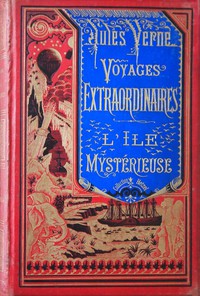The Mysterious Island by Jules Verne (ebook and pdf reader txt) 📖

- Author: Jules Verne
Book online «The Mysterious Island by Jules Verne (ebook and pdf reader txt) 📖». Author Jules Verne
It was about 7 o’clock in the morning when they left the camp. No one seemed dismayed by the situation. They had faith in themselves, no doubt; but the source of that faith was not the same with Smith as with his companions. They trusted in him, he in his ability to extort from the wilderness around them all the necessaries of life. As for Pencroff, he would not have despaired, since the rekindling of the fire by the engineer’s lens, if he had found himself upon a barren rock, if only Smith was with him.
“Bah!” said he, “we got out of Richmond without the permission of the authorities, and it will be strange if we can’t get away some time from a place where no one wants to keep us!”
They followed the route of the day before, flanking the cone till they reached the enormous crevasse. It was a superb day, and the southern side of the mountain was bathed in sunlight. The crater, as the engineer had supposed, was a huge shaft gradually opening to a height of 1,000 feet above the plateau. From the bottom of the crevasse large currents of lava meandered down the flanks of the mountain, indicating the path of the eruptive matter down to the lower valleys which furrowed the north of the island.
The interior of the crater, which had an inclination of thirty-five or forty degrees, was easily scaled. They saw on the way traces of ancient lava, which had probably gushed from the summit of the cone before the lateral opening had given it a new way of escape. As to the volcano chimney which communicated with the subterranean abyss, its depth could not be estimated by the eye, for it was lost in obscurity; but there seemed no doubt that the volcano was completely extinct. Before 8 o’clock, the party were standing at the summit of the crater, on a conical elevation of the northern side.
“The sea! the sea everywhere!” was the universal exclamation. There it lay, an immense sheet of water around them on every side. Perhaps Smith had hoped that daylight would reveal some neighboring coast or island. But nothing appeared to the horizon-line, a radius of more than fifty miles. Not a sail was in sight. Around the island stretched a desert infinity of ocean.
Silent and motionless, they surveyed every point of the horizon. They strained their eyes to the uttermost limit of the ocean. But even Pencroff, to whom Nature had given a pair of telescopes instead of eyes, and who could have detected land even in the faintest haze upon the sea-line, could see nothing. Then they looked down upon their island, and the silence was broken by Spilett:—
“How large do you think this island is?”
It seemed small enough in the midst of the infinite ocean.
Smith thought awhile, noticed the circumference of the island, and allowed for the elevation.
“My friends,” he said, “if I am not mistaken, the coast of the island is more than 100 miles around.”
“Then its surface will be—”
“That is hard to estimate; the outline is so irregular.”
If Smith was right, the island would be about the size of Malta or Zante in the Mediterranean; but it was more irregular than they, and at the same time had fewer capes, promontories, points, bays, and creeks. Its form was very striking. When Spilett drew it they declared it was like some fantastic sea beast, some monstrous pteropode, asleep on the surface of the Pacific.
The exact configuration of the island may thus be described:—The eastern coast, upon which the castaways had landed, was a decided curve, embracing a large bay, terminating at the southeast in a sharp promontory, which the shape of the land had hidden from Pencroff on his first exploration. On the northeast, two other capes shut in the bay, and between them lay a narrow gulf like the half-open jaws of some formidable dog-fish. From northeast to northwest the coast was round and flat, like the skull of a wild beast; then came a sort of indeterminate hump, whose centre was occupied by the volcanic mountain. From this point the coast ran directly north and south. For two-thirds of its length it was bordered by a narrow creek; then it finished in along cue, like the tail of a gigantic alligator. This cue formed a veritable peninsula, which extended more than thirty miles into the sea, reckoning from the southeastern cape before mentioned. These thirty miles, the southern coast of the island, described an open bay. The narrowest part of the island, between the Chimneys and the creek, on the west, was ten miles wide, but its greatest length, from the jaw in the northeast to the extremity of the southwestern peninsula, was not less than thirty miles.
The general aspect of the interior was as follows:—The southern part, from the shore to the mountain, was covered with woods; the northern part was arid and sandy. Between the volcano and the eastern coast the party were surprised to see a lake, surrounded by evergreens, whose existence they had not suspected. Viewed from such a height it seemed to be on the same level with the sea, but, on reflection, the engineer explained to his companions that it must be at least 300 feet higher, for the plateau on which it lay was as high as that of the coast.
“So, then, it is a fresh water lake?” asked Pencroff.
“Yes,” said the engineer, “for it must be fed by the mountain streams.”
“I can see a little river flowing into it,” said Herbert, pointing to a narrow brook whose source was evidently in the spurs of the western cliff.
“True,” said Smith, “and since this brook flows into the lake, there is probably some outlet towards the sea for the overflow. We will see about that when we go back.”
This little winding stream and the river so familiar to them were all the watercourses they could see. Nevertheless, it was possible that under those-masses of trees which covered two-thirds of the island, other streams flowed towards the sea. This seemed the more probable from the fertility of the country and its magnificent display of the flora of the temperate zone. In the northern section there was no indication of running water; perhaps there might be stagnant pools in the swampy part of the northeast, but that was all; in the main this region was composed of arid sand-hills and downs, contrasting strongly with the fertility of the larger portion.
The volcano did not occupy the centre of the island. It rose in the northwest, and seemed to indicate the dividing line of the two zones. On the southwest, south, and southeast, the beginnings of the spurs were lost in masses of verdure. To the north, on the contrary, these ramifications were plainly visible, subsiding gradually to the level of the sandy plain. On this side, too, when the volcano was active, the eruptions had taken place, and a great bed of lava extended as far as the narrow jaw which formed the northeastern gulf.
They remained for an hour at the summit of the mountain. The island lay stretched before them like a plan in relief, with its different tints, green for the forests, yellow for the sands, blue for the water. They understood the configuration of the entire island; only the bottoms of the shady valleys and the depths of the narrow gorges between the spurs of the volcano, concealed by the spreading foliage, escaped their searching eye.
There remained a question of great moment, whose answer would have a controlling influence upon the fortunes of the castaways. Was the island inhabited? It was the reporter who put this question, which seemed already to have been answered in the negative by the minute examination which they had just made of the different portions of the island. Nowhere could they perceive the handiwork of man; no late settlement on the beach, not even a lonely cabin or a fisherman’s hut. No smoke, rising on the air, betrayed a human presence. It is true, the observers were thirty miles from the long peninsula which extended to the southwest, and upon which even Pencroff’s eye could hardly have discovered a dwelling. Nor could they raise the curtain of foliage which covered three-fourths of the island to see whether some village lay sheltered there. But the natives of these little islands in the Pacific usually live on the coast, and the coast seemed absolutely desert. Until they should make a more complete exploration, they might assume that the island was uninhabited. But was it ever frequented by the inhabitants of neighboring islands? This question was difficult to answer. No land appeared within a radius of fifty miles. But fifty miles could easily be traversed by Malay canoes or by the larger pirogues of the Polynesians. Everything depended upon the situation of the island—on its isolation in the Pacific, or its proximity to the archipelagoes. Could Smith succeed, without his instruments, in determining its latitude and longitude? It would be difficult, and in the uncertainty, they must take precautions against an attack from savage neighbors.
The exploration of the island was finished, its configuration determined, a map of it drawn, its size calculated, and the distribution of its land and water ascertained. The forests and the plains had been roughly sketched upon the reporter’s map. They had only now to descend the declivities of the mountain, and to examine into the animal, vegetable, and mineral resources of the country. But before giving the signal of departure, Cyrus Smith, in a calm, grave voice, addressed his companions.
“Look, my friends, upon this little corner of the earth, on which the hand of the Almighty has cast us. Here, perhaps, we may long dwell. Perhaps, too, unexpected help will arrive, should some ship chance to pass. I say chance, because this island is of slight importance, without even a harbor for ships. I fear it is situated out of the usual course of vessels, too far south for those which frequent the archipelagoes of the Pacific, too far north for those bound to Australia round Cape Horn. I will not disguise from you our situation.”
“And you are right, my dear Cyrus,” said the reporter, eagerly. “You are dealing with men. They trust you, and you can count on them. Can he not, my friends?”
“I will obey you in everyting [sic], Mr. Smith,” said Herbert, taking the engineer’s hand.
“May I lose my name,” said the sailor, “if I shirk my part! If you choose, Mr. Smith, we will make a little America here. We will build cities, lay railroads, establish telegraphs, and some day, when the island is transformed and civilized, offer her to the United States. But one thing I should like to ask.”
“What Is that?” said the reporter.
“That we should not consider ourselves any longer as castaways, but as colonists.”
Cyrus Smith could not help smiling, and the motion was adopted. Then Smith thanked his companions, and added that he counted upon their energy and upon the help of Heaven.
“Well, let’s start for the Chimneys,” said Pencroff.
“One minute, my friends,” answered the engineer; “would it not be well to name the island, as well as the capes, promontories, and water-courses, which we see before us?”
“Good,” said the reporter. “That will simplify for the future the instructions which we may have to give or to take.”
“Yes,” added the sailor, “it will be something gained to be able to say whence we are coming and where we are going. We shall seem to be somewhere.”
“At the Chimneys, for instance,” said Herbert.
“Exactly,” said the sailor. “That name has been quite convenient already, and I was the author of it. Shall we keep that name for our first encampment, Mr. Smith?”
“Yes, Pencroff, since you baptized it so.”
“Good! the others will be easy enough,” resumed the sailor, who was now in the vein. “Let us give them names like those of the Swiss family Robinson, whose story Herbert has read me more than once:—’Providence Bay,’ ‘Cochalot Point,’ ‘Cape Disappointment.’“
“Or rather Mr. Smith’s name, Mr. Spilett’s, or Neb’s,” said Herbert.
“My name!” cried Neb, showing his white teeth.
“Why not?” replied Pencroff, “‘Port Neb’ would sound first-rate! And ‘Cape Gideon’—”
“I would rather have names, taken from our country,” said the reporter, “which will recall America to us.”
“Yes,” said Smith, “the principal features, the bays and seas should be so named. For instance, let us call the great bay to the east Union Bay, the southern indentation Washington Bay, the mountain on which we are standing Mount Franklin, the lake beneath our feet Lake Grant. These names will recall our country and the great citizens who have honored it; but for the smaller features, let us choose names which will suggest their especial configuration. These will remain
 Have you ever thought about what fiction is? Probably, such a question may seem surprising: and so everything is clear. Every person throughout his life has to repeatedly create the works he needs for specific purposes - statements, autobiographies, dictations - using not gypsum or clay, not musical notes, not paints, but just a word. At the same time, almost every person will be very surprised if he is told that he thereby created a work of fiction, which is very different from visual art, music and sculpture making. However, everyone understands that a student's essay or dictation is fundamentally different from novels, short stories, news that are created by professional writers. In the works of professionals there is the most important difference - excogitation. But, oddly enough, in a school literature course, you don’t realize the full power of fiction. So using our website in your free time discover fiction for yourself.
Have you ever thought about what fiction is? Probably, such a question may seem surprising: and so everything is clear. Every person throughout his life has to repeatedly create the works he needs for specific purposes - statements, autobiographies, dictations - using not gypsum or clay, not musical notes, not paints, but just a word. At the same time, almost every person will be very surprised if he is told that he thereby created a work of fiction, which is very different from visual art, music and sculpture making. However, everyone understands that a student's essay or dictation is fundamentally different from novels, short stories, news that are created by professional writers. In the works of professionals there is the most important difference - excogitation. But, oddly enough, in a school literature course, you don’t realize the full power of fiction. So using our website in your free time discover fiction for yourself. 




Comments (0)